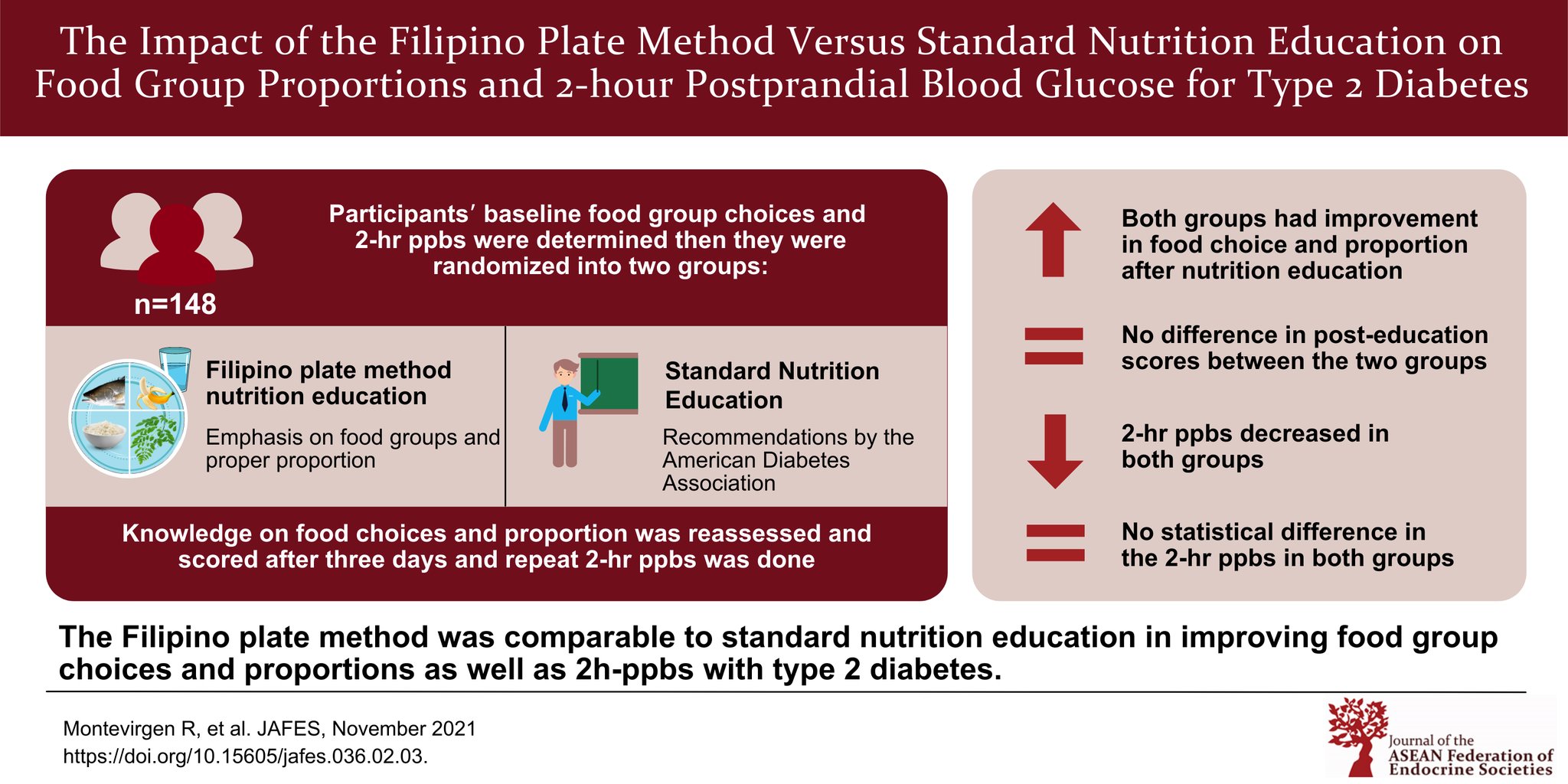The Impact of the Filipino Plate Method versus Standard Nutrition Education on Food Group Proportions and 2-hour Postprandial Blood Glucose for Type 2 Diabetes
DOI:
https://doi.org/10.15605/jafes.036.02.03Keywords:
diabetes, nutrition, post prandial glucoseAbstract
Objectives. To compare the efficacy of the Filipino plate method against standard nutrition education in the selection of food group proportions and in reducing 2-hour postprandial blood glucose levels (2h-PPG) among patients with type 2 diabetes.
Methodology. This randomized, open-label trial assigned 148 subjects with type 2 diabetes to receive nutrition education using either the Filipino plate method or standard nutrition education, as recommended by the American Diabetes Association (ADA). The subjects were given meals before and three days after the intervention, at which time the contents of their plate were scored based on food group proportions. After the meal, 2h-PPG levels were obtained. Pre- and post-intervention plate scores and 2h-PPG were compared in both groups.
Results. Plate scores were significantly increased from pre to post-teaching for both groups (p value <0.001). There was no statistically significant difference in post-teaching scores between the two modes of nutrition education (Filipino plate method median score 8/9 vs standard nutrition education 7/9, p=0.018). The 2h-PPG results decreased significantly from baseline to post-teaching for both groups (p=0.008). There was no significant difference in the reduction in 2h-PPG between the two groups (p=.741).
Conclusion. The Filipino plate method was comparable to standard nutrition education in improving food group choices and proportions as well as 2h-PPG in patients with type 2 diabetes.
Downloads
References
International Diabetes Federation. The Philippines. Available from: https://www.idf.org/our-network/regions-members/western-pacific/members/116-the-philippines.html.
Meigs JB. Epidemiology of type 2 diabetes and cardiovascular disease: Translation from population to prevention. Diabetes Care. 2010;33(8):1865-71. https://pubmed.ncbi.nlm.nih.gov/20668155. https://www.ncbi.nlm.nih.gov/pmc/articles/PMC2909080. https://doi.org/10.2337/dc10-0641.
The Diabetes Control and Complications Trial Research Group; Nathan DM, Genuth S, et al. The effect of intensive treatment of diabetes on the development and progression of long-term complications in insulin-dependent diabetes mellitus. N Engl J Med. 1993;329(14):977–86. https://pubmed.ncbi.nlm.nih.gov/8366922. https://doi.org/10.1056/NEJM199309303291401.
Intensive blood-glucose control with sulphonylureas or insulin compared with conventional treatment and risk of complications in patients with type 2 diabetes (UKPDS 33). UK Prospective Diabetes Study (UKPDS) Group. Lancet. 1998;352(9131):837–53. https://pubmed.ncbi.nlm.nih.gov/9742976.
DeFronzo RA, Ferrannini E, Groop L, et al. Type 2 diabetes mellitus. Nat Rev Dis Prim. 2015;1:15019. https://pubmed.ncbi.nlm.nih.gov/27189025. https://doi.org/10.1038/nrdp.2015.19.
Evert AB, Boucher JL, Cypress M, et al. Nutrition therapy recommendations for the management of adults with diabetes. Diabetes Care. 2013;36(11):3821-42. https://pubmed.ncbi.nlm.nih.gov/24107659. https://www.ncbi.nlm.nih.gov/pmc/articles/PMC3816916. https://doi.org/10.2337/dc13-2042.
Camelon KM, Hådell K, Jämsén PT, et al. The plate model: A visual method of teaching meal planning. DAIS Project Group. Diabetes Atherosclerosis Intervention Study. J Am Diet Assoc. 1998; 98(10):1155-8. https://pubmed.ncbi.nlm.nih.gov/9787722. https://doi.org/10.1016/s0002-8223(98)00267-3.
Idaho plate method. Rexburg (ID): Idaho Plate Method. Available from: http://platemethod.com.
DOST-FNRI. Filipino plate method. “Pinggang Pinoy.” Available from: https://www.fnri.dost.gov.ph/index.php/tools-and-standard/pinggang-pinoy.
Franz MJ, Powers MA, Leontos C, et al. The evidence for medical nutrition therapy for type 1 and type 2 diabetes in adults. J Am Diet Assoc. 2010;110(12):1852-89. https://pubmed.ncbi.nlm.nih.gov/21111095. https://doi.org/10.1016/j.jada.2010.09.014.
Davies MJ, D’Alessio DA, Fradkin J, et al. Management of hyperglycaemia in type 2 diabetes, 2018. A consensus report by the American Diabetes Association (ADA) and the European Association for the Study of Diabetes (EASD) Diabetologia. 2018;61(12):2461–98. https://pubmed.ncbi.nlm.nih.gov/30288571. https://doi.org/10.1007/s00125-018-4729-5.
Diabetes Canada Clinical Practice Guidelines Expert Committee. 2018 Clinical Practice Guidelines for the prevention and management of Diabetes in Canada. Can J Diab. 2018;42(Suppl 1):S1-S325. Available from: http://guidelines.diabetes.ca/docs/CPG-2018-full-EN.pdf.
Norris SL, Engelgau MM, Narayan KM. Effectiveness of self-management training in type 2 diabetes: A systematic review of randomized controlled trials. Diabetes Care. 2001;24(3):561–87. https://pubmed.ncbi.nlm.nih.gov/11289485. https://doi.org/10.2337/diacare.24.3.561.
Siminerio LM, Piatt G, Zgibor JC. Implementing the chronic care model for improvements in diabetes care and education in a rural primary care practice. Diabetes Educ. 2005;31(2):31:225–34. https://pubmed.ncbi.nlm.nih.gov/15797851. https://doi.org/10.1177/0145721705275325.
Siminerio LM, Piatt GA, Emerson S, et al. Deploying the chronic care model to implement and sustain diabetes self-management training programs. Diabetes Educ. 2006;32(2):253–60. https://pubmed.ncbi.nlm.nih.gov/16554429. https://doi.org/10.1177/0145721706287156.

Published
How to Cite
Issue
Section
License
Copyright (c) 2021 Richultz Cruz Montevirgen, Kristine Bea Mendoza, Lizette Kristine Lopez

This work is licensed under a Creative Commons Attribution-NonCommercial 4.0 International License.
Journal of the ASEAN Federation of Endocrine Societies is licensed under a Creative Commons Attribution-NonCommercial 4.0 International. (full license at this link: http://creativecommons.org/licenses/by-nc/3.0/legalcode).
To obtain permission to translate/reproduce or download articles or use images FOR COMMERCIAL REUSE/BUSINESS PURPOSES from the Journal of the ASEAN Federation of Endocrine Societies, kindly fill in the Permission Request for Use of Copyrighted Material and return as PDF file to jafes@asia.com or jafes.editor@gmail.com.
A written agreement shall be emailed to the requester should permission be granted.









